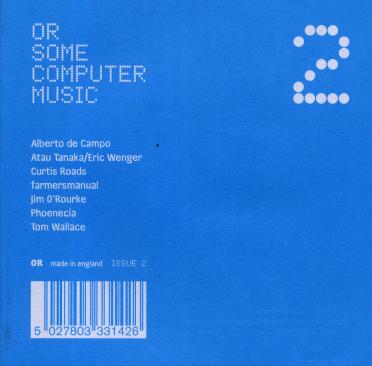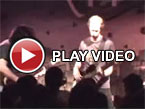"OR SOME COMPUTER MUSIC 2"
 This compilation, described as 'difficult listening' in the pressrelease, could be fuel to claims that much computer music is barking upseemingly generic alleyways since this could all quite conceivably bethe work of just a couple of artists. However I see this more as anindication that compiler Russell Haswell has fairly consistant tastesand has done a pretty good job of sequencing the tracks.There seems to be a fairly equal footing for the highly seriousacademic side of computer music and the perhaps more frivolous rockpopsside (Jim O'Rourke, Tom Wallace, Farmers Manual, Phoenecia). Theacademics all provide ample detail on the concepts steering theircompositions, whereas the digital rockpops laptop fraternity provide afew screen grab pictures or in the case of Tom Wallace, no informationat all. Perhaps the 'fuck off' finger on the farmersmanual desktop sumsup the attitude.Farmers Manual open and close the compilation, and their unassuminglittle digiglitch flutter fanfare starting snippet gives hardly a clueof the awesome low floor shaking rumble of the monstrous live recordingthat rounds things off. This track alone makes it a worthwhilepurchase, but the rest is enjoyable too.Jim O'Rourke, Tom Wallace and Phoenecia all pull similar tricks withvarying degrees of daftness. Phoenecia place relentlessly mouseshifting bubbles and cracks over intermittent drones. O'Rourke throwssome tropical Ai yi yi ya singing into his fluttering stew of rockglitched to death and Tom Wallace mixes the sounds of breaking bottleswith what sounds like a rock band trying to start a song and cuttingoff sporadically. It's really quite silly, with silent stretchesencroaching latterly making the sporadic bursts of noise all the moreridiculous.Rather more serious is Super Collider 2 workshop lecturer Alberto deCampo's synthesis of a pleasantly atmospheric droning green and blueworld. He processed sound sources which have a 'rich symbolic aura',such as nightingales, meditation bells and cymbals, ritual mantras andchanting. None of these sources are readily identifiable but their auraremains in this eerily evocative foray that certainly avoids the 'NewAge' alarms that the accompanying article might set off.Fellow academic Curtis Roads espouses the exploration of 'soundparticles', microsound 'beneath the level of the note' and he even hasa picture to prove it! And well he might, but his cut up computercollage isn't drastically removed from the soundworlds of Phoenecia orTom Wallace. Maybe laptoppers have been exploring the realm ofmicrosound for years without actually knowing it!Atau Tanaka and Eric Wenger created 'Bondage' using software that turnsscanned photographs of Japanese women tied up in knots into sound, andit's a detailed suite that shifts moods rapidly from intensity torelief. What they did with the photographs after they finished makingdeep dark dungeon noises isn't mentioned in the booklet, but they didhave the permission of the artist.
This compilation, described as 'difficult listening' in the pressrelease, could be fuel to claims that much computer music is barking upseemingly generic alleyways since this could all quite conceivably bethe work of just a couple of artists. However I see this more as anindication that compiler Russell Haswell has fairly consistant tastesand has done a pretty good job of sequencing the tracks.There seems to be a fairly equal footing for the highly seriousacademic side of computer music and the perhaps more frivolous rockpopsside (Jim O'Rourke, Tom Wallace, Farmers Manual, Phoenecia). Theacademics all provide ample detail on the concepts steering theircompositions, whereas the digital rockpops laptop fraternity provide afew screen grab pictures or in the case of Tom Wallace, no informationat all. Perhaps the 'fuck off' finger on the farmersmanual desktop sumsup the attitude.Farmers Manual open and close the compilation, and their unassuminglittle digiglitch flutter fanfare starting snippet gives hardly a clueof the awesome low floor shaking rumble of the monstrous live recordingthat rounds things off. This track alone makes it a worthwhilepurchase, but the rest is enjoyable too.Jim O'Rourke, Tom Wallace and Phoenecia all pull similar tricks withvarying degrees of daftness. Phoenecia place relentlessly mouseshifting bubbles and cracks over intermittent drones. O'Rourke throwssome tropical Ai yi yi ya singing into his fluttering stew of rockglitched to death and Tom Wallace mixes the sounds of breaking bottleswith what sounds like a rock band trying to start a song and cuttingoff sporadically. It's really quite silly, with silent stretchesencroaching latterly making the sporadic bursts of noise all the moreridiculous.Rather more serious is Super Collider 2 workshop lecturer Alberto deCampo's synthesis of a pleasantly atmospheric droning green and blueworld. He processed sound sources which have a 'rich symbolic aura',such as nightingales, meditation bells and cymbals, ritual mantras andchanting. None of these sources are readily identifiable but their auraremains in this eerily evocative foray that certainly avoids the 'NewAge' alarms that the accompanying article might set off.Fellow academic Curtis Roads espouses the exploration of 'soundparticles', microsound 'beneath the level of the note' and he even hasa picture to prove it! And well he might, but his cut up computercollage isn't drastically removed from the soundworlds of Phoenecia orTom Wallace. Maybe laptoppers have been exploring the realm ofmicrosound for years without actually knowing it!Atau Tanaka and Eric Wenger created 'Bondage' using software that turnsscanned photographs of Japanese women tied up in knots into sound, andit's a detailed suite that shifts moods rapidly from intensity torelief. What they did with the photographs after they finished makingdeep dark dungeon noises isn't mentioned in the booklet, but they didhave the permission of the artist.
samples:
- Alberto De Campo - Imaon
- Phoenecia - Non-Specific Acoustic Stimulation
- Atau Tanaka & Eric Wenger - Bondage



